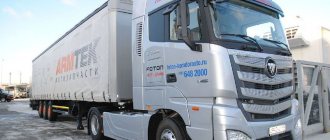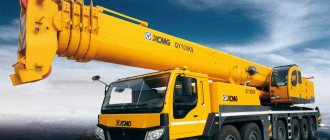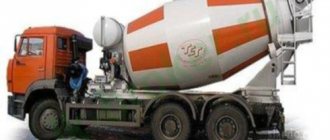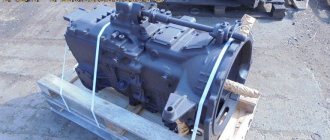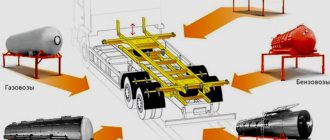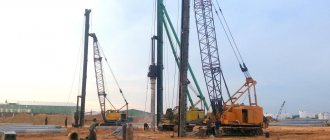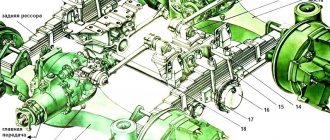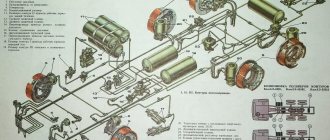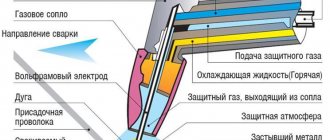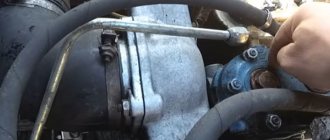A van on a truck is mounted behind the cab and is necessary for transporting goods. Depending on the cargo being transported, there are three types of vans: manufactured goods, isothermal and refrigerated. Any non-food cargo is transported in a manufactured goods van. In an isothermal van it is possible to transport both non-food cargo and food, the storage temperature, which can be achieved in the van during transportation. A refrigerator is an isothermal van with a refrigeration unit (refrigeration and heating unit) designed for transporting food products with certain temperature storage conditions.
Manufactured goods van
Designed for transporting goods that do not require restrictions on temperature and humidity. Perfect for protecting cargo from unauthorized persons, as well as from external factors (precipitation, dirt, dust). Due to the fact that the thermal conductivity coefficient of the material from which the van is made is more than 0.7 W/m²⋅°C, it is impossible to transport cargo with certain temperature conditions in this van. The undeniable advantage of this van is its price; it is much cheaper than an isothermal van.
There are 3 types of manufactured goods vans:
- Frame;
- Beskarskasny;
- European industrial goods.
Types
What types of vans are available?
Let's look at some of the most popular van types and specifications, grouped by size and type:
Small vans
Size is a deciding factor for a van, so much so that it can be a more important consideration than the type of van. Small vans such as the Citroen Berlingo have a short wheelbase and greater agility, but obviously offer less payload.
Medium vans
Neatly bridging the gap between small and large vans, midsize vans offer plenty of storage space as well as a comfortable ride that's indistinguishable from a regular passenger car. Camper vans and mid-panel vans such as the Ford Transit Custom are classified as mid-panel vans.
Large vans
Providing maximum payload, large vans have a long wheelbase and offer a smoother drive thanks to more space between the axles. Large vans such as Luton/box vans, Mercedes-Benz Sprinter vans are the largest vans.
Pickup / 4x4
Pickup trucks are easily recognizable as they have an open cargo area at the rear behind the cab, similar to the Mitsubishi L200. Also considered a truck, this type of van often comes in either two- or four-wheel drive and is popular with people who are used to purchasing goods in one go.
Combi vans
hazy uit led +
Capable of carrying people and/or cargo in comfort, many combination or passenger vans include folding seats to further increase cargo space. Examples of combi vans include the Renault Trafic.
Minibus
Great for large families, vans and multi-purpose vehicles have up to seven passenger seats, two of which should be able to fold flat to the floor. This type of van should offer comfort and space, just like the Volkswagen Caravelle does.
Luton/box van
This type of van includes an enclosed body - a tall, square cargo area - with a separate cabin and is usually wider than a panel van. An example of a Luton van is the Peugeot Boxer. This type of van is a favorite of couriers and delivery drivers as the square shape makes it easier to deliver larger parcels or bulkier items. These vans usually only have access from the rear doors and often have lifts to make loading easier, as they are often higher off the ground.
Tipper/dropside van
Strictly speaking, a dump truck or dropside van is a subtype of pickup truck, but with a bed that lifts up at the front to “tip” the contents at the rear. Some tippers also allow you to tilt to either side, as well as to the rear, like the Ford Transit Dropside.
Frame manufactured goods van
Consists of a frame and casing. A metal profile is used as a frame, which is sheathed with sheets of various materials (metal, plastic, plywood). This design is the simplest and cheapest. The lathing is made from the inside and outside with aluminum or plastic corners. The main disadvantage of this van is its weight, which is greater than a frameless one. The base of the van is a subframe with longitudinal side members that are attached to the chassis frame. The flooring is often transportable moisture-resistant plywood 20mm thick.
Euro industrial goods van
Frameless consists of self-supporting sandwich panels 30mm thick, all walls, floor - 75mm framed with aluminum or galvanized corners 2mm thick. Suitable for transporting non-food goods, as well as frame and frameless manufactured goods vans, as well as cargo that has a significant temperature range for transportation (paints, drinks, cereals, flour, sugar, groceries, fruits and vegetables). Installing a HOU or a heater in a European industrial van is not advisable, since the thermal conductivity coefficient is higher than 0.7 W/m²⋅°C. The advantages of this van are that it is lighter than a frame van and more reliable than a frameless manufactured goods van. The price of this van is approximately equal to a frame insulated van. Another undeniable advantage is that there are no hard-to-reach places inside the van, and cleaning in this van is much easier than in a framed or frameless one. The durability of this van under normal service conditions is about 15 years.
Criterias of choice
When choosing a van, consider:
- Purpose. What will the campervan be used for? There are many universal and highly specialized models available for sale, differing in technical characteristics and price.
- Terms of Use. What average distances will the work machine travel? Where will you travel most of the time? On city roads, rough terrain or highways. Pay attention to the climatic conditions in the region and the general condition of the road surface.
- Volume and design of the cargo compartment. How much cargo must be transported in one flight? What cargo compartment configuration will be optimal? Do you need refrigeration, refrigeration and heating units? What characteristics should they have? All this depends on the type of cargo being transported and the requirements for its transportation (temperature and humidity level, absence of strong shaking).
- Maximum load capacity. Much depends on the type of chassis. However, there may be different models within the same category. For example, the all-metal Transporter van is available in versions with a load compartment volume of 4.4 m3 and larger.
- Motor. Vans are often supplied with high-torque diesel engines, which are distinguished by their long service life and resistance to intensive use. There are also compact vans (based on a station wagon) with a gasoline power unit. When choosing, take into account power and torque indicators, efficiency, overall reliability and maintainability of the engine.
- Equipment. The level of equipment comes to the fore when purchasing a van for transporting passengers alone. This concerns the quality of the seats and the finishing materials used, the availability of options for long-distance travel and other points. However, even in conventional cargo vans, you need to pay attention to the comfort of the driver and the presence of basic things as standard.
When choosing a van, consider the loading height and width of the cargo compartment (affect the convenience of loading and unloading), the type of drive and ground clearance (affect cross-country ability).
Frame isothermal van
It consists of a frame and insulation (foam plastic, polyurethane foam, etc.) covered with laminated plywood or clad metal sheets. Framing the van with galvanized or aluminum corners. A thermal conductivity coefficient of less than 0.7 W/m²⋅°C is achieved by a thickness of insulation in the walls, floor and roof from 30 to 100 mm. The advantages of this van are its ease of repair and low price. The main disadvantage of a frame isothermal van is thermal bridges (temperature bridge) - lies in the difference in thermal conductivity of the metal frame and insulation. Because of this difference, the frame gives off heat faster than the insulation, condensation occurs at the joint and moisture forms, as a result of which the insulation becomes moldy and collapses. Also, due to the large number of fastenings of frame profiles (longitudinal profiles with cross members), it can become loose, which leads to a decrease in tightness along the length until the insulating layer is destroyed. The service life of this van is on average 3-5 years.
Frameless van
A modern type of van consisting of self-supporting sandwich panels. Sandwich panels can be 3- or 5-layer, in the center of which there is insulation and sheathing glued to it on both sides (3-layer) and plywood glued to both sides and sheathing on top of it (5-layer). Depending on the purpose of the van, one or another panel is used for the walls. The panels are fastened using locks and adhesive. The undeniable advantage of this van is the absence of thermal bridges, as well as lower weight compared to a frame van. The downside is the higher price compared to the frame one.
| Polystyrene foam (expanded polystyrene) |
It is produced by thermal exposure of polystyrene granules using a blowing agent. The main advantages of this type of insulation are environmentally friendly, moisture-proof, the ability to resist evenly distributed mechanical loads (gives the van wall additional rigidity), and it is also inexpensive. Thermal conductivity coefficient 0.03…0.045 W/m²⋅°C
| Extruded polystyrene foam (EPS) |
They are made from the same substance as expanded polystyrene, but they have different technologies for creating granules. This type of polystyrene foam is produced using extrusion. A foaming agent is added to the molten mass of polystyrene, followed by passing through an extruder. In this way, very small granules with a diameter of up to 0.2 mm are obtained. EPPS has a low thermal conductivity coefficient (0.029 - 0.034), thereby surpassing expanded polystyrene, which has a thermal conductivity coefficient (0.03...0.045).
Refrigerator
It is an isothermal van with a thermal conductivity coefficient of less than 0.7 W/m²⋅°C with the addition of a refrigeration and heating unit (HOU). Depending on the degree of isothermality of the van, chemical dispensers of a certain class are installed. It is important to know that a refrigerated van is not intended for freezing or heating food, but only for maintaining temperature conditions for transportation.
Classes of refrigeration units:
- Class A (from +12°C to 0°C inclusive) low isothermal thermal conductivity coefficient - 0.55...0.7 W/m²⋅°C;
- Class B (from +12°C to -10°C inclusive) average isothermal thermal conductivity coefficient - 0.4...0.55 W/m²⋅°C;
- Class C (from +12°C to -20°C inclusive) high isothermal thermal conductivity coefficient - less than 0.4 W/m²⋅°C.
Which campervan should you choose?
The van must be well adapted to difficult operating conditions on the territory of the Russian Federation, associated with the quality of the road surface and changing climatic conditions.
The presented top vans indicate that it is now easy to choose a vehicle for specific tasks. Most manufacturers allow you to configure the car at your discretion. Literally everything is selected: the length of the base, the volume of the cargo compartment, the engine, the level of equipment, etc., it all depends on the purpose of the van.
